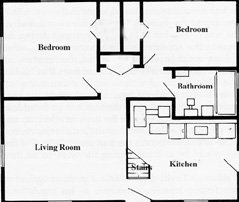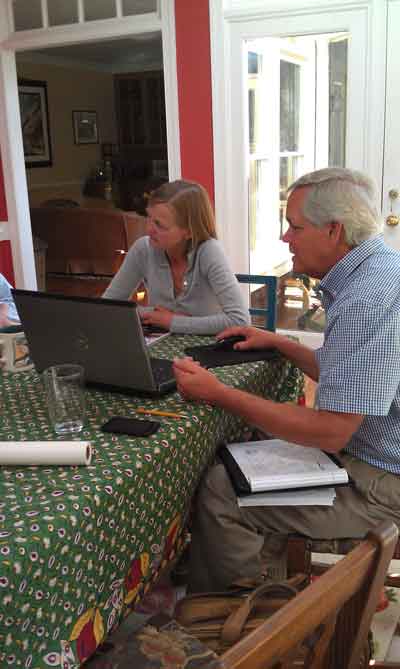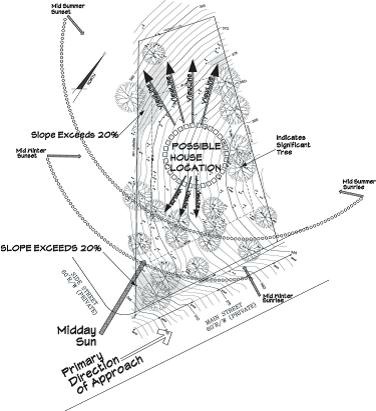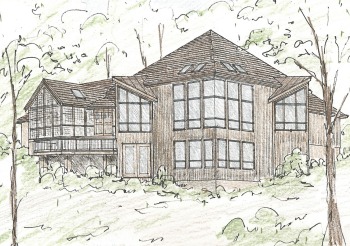Create the Best House Design by Using the Right Process

There are four basic ways people approach the task of creating a house design:
1. Search through books of House Floor Plans.
2. Design it themselves on paper or with Home Design Software.
3. Work with a builder in a Design-Build arrangement.
Searching through hundreds of House Floor Plans hoping to find the perfect dream home can be a frustrating process. You would think with so many house designs to choose from, one should be perfect. But it never really seems to work that way. Most plans are just plain bad. In others, you might find some features that you like, but none of the designs meets all your needs. House Plan Books are a good place to start, but even the best plan will need modifications to really come close to being Your Perfect House.

The do-it-yourselfers take out the graph paper, pencil, and Architect Scale, or buy some Home Design Software, and start sketching in hopes of getting a great plan. Usually this produces a plan, but not a great plan. The design often ends up with many compromises and things that just are not worked out very well. To make this effort work as well as possible, you need to write out a Program and get your objectives clearly defined from the beginning. Then, as you work through the design, you will be able to gauge your progress and know if you have achieved your goals.
To avoid frustration, many people go to a builder who offers Design-Build services. The builder may design the house himself, or he may retain a draftsman, house designer, or maybe even an architect create the house design. This arrangement can work well, if you take the proper steps along the way and if the person doing the design is talented and responsive to you. But if you aren’t lucky enough to get a builder with an eye for design, you might end up with a well-built house, but a design that is less than perfect.
The best approach to house design involves Hiring an Architect or residential designer and then working through a proper Custom Home Design process. Obviously, since I’m an architect myself, I am biased toward this approach. But setting aside my bias, I can confidently say that this method will give you the best house designed specifically for you and your family. And, believe it or not, it just might be the most economical way to go since a good design can be a more efficient use of space, save you from expensive mistakes, and produce a house that holds its value well over the years.
Add to that the joy of living in a house that fits you comfortably and makes you truly happy, and you have a valuable combination that is worthy of the effort and expense.
Make sure you’re prepared. Do your homework
But be forewarned, all of these house design methods will fail if you are not prepared and have not done enough homework to guide the entire process in the right direction. The goal of this website is to give you good information about house design, increase your awareness of the possibilities you have, give you good answers, and arm you with knowledge.
Every good house design starts with some solid House Planning. You might call this Pre-Planning. We architects call this step “Programming.” I like to say that if you don’t know where you’re going, you’ll never know when you get there. Programming tells you where you are going. This is when you set your goals. How would you like your house to live? How big should it be? What is your budget?
If you do a thorough job of programming, you’ll have a yardstick by which to measure any design. Even if you are simply choosing a stock plan, good House Planning will help you evaluate how well each plan fulfills your program requirements. If you are designing from scratch, your program is your roadmap to the perfect house design.

You probably have heard Home Construction Costs expressed in terms of Cost per Square Foot. This term is an industry standard, but there different ways square footage is calculated. One builder might include the unheated spaces, such as the garage. Another builder might only count the heated space. Naturally, these differences will cause the dollar amounts quoted for the cost per square foot to vary. Be sure you know How to Calculate Square Footage correctly so you understand the reality of your Home Construction Costs.
Don’t delude yourself into thinking that by some miracle your house will be less expensive than the rest of the houses in your community with the same level of quality and detail. It’s a fool’s game. Reality will eventually prevail, leading you to the disappointing prospect of abandoning your home you’ve worked so hard to design perfectly.
An important factor in controlling costs and avoiding building useless square footage is by understanding proper Room Design and setting target room sizes that are not too large or too small. If you add everything up before drawing your House Floor Plans, making the size adjustments when everything is merely a list of target sizes, you will then be free to Design Your Own Home or even pick a plan with the confidence you will be able to afford it.
When people don’t start out with realistic House Planning, they usually end up feeling like they’ve compromised. Your dream home should not be a compromise.
Take Advantage of What Your Site Has to Offer

I believe every house should “respond” to the Building Site. It should sit comfortably on the slope of the land and take advantage of all the site has to offer. There is nothing worse than seeing a house that is inappropriate to a piece of property and was plopped down willy-nilly. Usually this results in lost opportunities.
Often the best views are ignored, the house does not look as good as it could, the solar orientation is wrong and the house is less energy efficient than it might have been, the rooms are dark, or a host of other problems.

After, your House Planning is done, the Building Site should be analyzed to delineate sun angles, prevailing winds, topography, site features, significant trees, neighboring buildings, property lines, building setbacks, easements, and other characteristics that will influence the design of your house.
Topography is the slope of the land. This information usually comes from a land surveyor. Too many times people avoid the cost of a survey only to find out too late that there was not enough slope for the walk-out Basement they wanted or there is a drainage problem they did not foresee.
Your house design starts from the ground up. Knowing about the ground your house sits upon will give you the best start for your design. When I’m working on a house design, I like to start with the written program and then create a bubble diagram showing the rooms and spaces, but with no indication of the shape of the rooms.
My bubble diagram will show how rooms interact. I’ll draw lines to show which rooms must be adjacent to which other rooms. Then I gradually manipulate the rooms to find the optimal arrangement that yields the right interconnections based on the program.
Once I have a feel for the diagrammatic house layout, I try placing the diagram on the Building Site and then alter it to capture the site opportunities, such as views, sun angles, etc. From this new, modified diagram, I can easily develop a floor plan that fulfills the program and responds to the site. I explain this in detail in my book, Designing Your Perfect House: Lessons from an Architect.

Not every floor plan can work with every Exterior Home Design. The interior and the exterior need to be compatible. You might find yourself attracted to one style of house only to learn later it is appropriate for two-story houses and doesn’t match up well with the one-story plan you want. Don’t fret. It’s a normal part of the house design process to take the diagrammatic floor plan and modify it while you’re developing the exterior design.
One aspect of the house will always influence other aspects. The trick is to maximize all aspects without letting anything suffer severely at the hands of another. House design is one big balancing act. If you can ultimately get 90% of everything, you’ll have a great design.
The Roof Design is the Crowning Touch
Roof Designs have a large impact on the look of your home. It’s a good idea to become familiar with the names of each roof shape and style and the impact each one can have on the house. If you’re interested in maximum energy efficiency, you’ll probably want a roof designed with large overhangs to shade your windows in summer.
If you live in a snowy climate, you might want to consider steeper sloping roofs and avoid valleys where snow and ice can build up. Flat roofs can suit arid climates. Roofs with the proper pitch and orientation can hold solar panels. Not every roof is appropriate for every climate.
Every good house design needs an organizing concept. The best houses give you the sense that everything is in the right place. And good house design tends to look like it was easy to create, even if it wasn’t. It’s like watching a great athlete. You know what they are doing is hard, but they make it look effortless. If you plan your house out well, analyze the site, work with an organizing concept, and keep referring to your program to be sure you are designing a house that fulfills it, success is a near certainty.
House design covers a lot of territory. It includes Kitchen Design and Bathroom Design, design of special rooms like Home Theaters, Home Offices, and Garages. Your new house must comply with the Residential Building Code.
There are issues of scale and proportion, energy efficiency, and special details. It can’t be summed up in a few pages.
I cover much of this in Designing Your Perfect House and elsewhere on this website. So take the time to explore. There’s lots of information here and more is added frequently. Check back to see what’s new. You’ll probably find a few more Home Design Tips every time.

I hope this information is helpful to you. You might want to get yourself a copy of my best-seller, Designing Your Perfect House. It is chockfull of valuable tips and advice that will save you many times the cost of the book on your house building or remodeling project. You might also like The Well-Centered Home: Simple Steps to Increase Mindfulness, Self-Awareness, and Happiness Where You Live. It will show you how to make your home a happy place.

